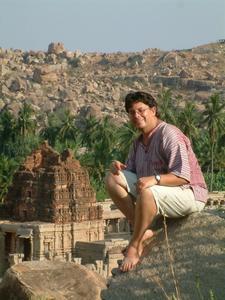Advertisement
Published: March 9th 2005

 Welcome to Hampi
Welcome to Hampi
Looking down on centuries old temples gives you a great feelingThe train from Bangalore took us to
Hospet, the nearest railway station to
Hampi. Although it offers more varied accommodation than Hampi, we decided to establish ourselves as close to the attractions as possible. Hampi is a mecca for backpackers, without the tourists the village would not even exist. There are no hotels in the strict sense, only a couple of private houses, which offer rooms on the upper floors. We chose the best one (everything is relative) with private shower since we were not in the mood for a shared bathroom. To all the foreigners who are fed up with Indian cuisine, Hampi appears like paradise, offering Italian pizza or pasta as well as American and Israeli dishes. You can find almost everything, apart from fast internet or shower gel.
Hampi was once the seat of the
Vijayanagara Empire (from 1336 onwards) and enormously wealthy, having held a monopole of trade on different goods until the city was largely destroyed in 1565. Today the stark and barren area of 26 sq km by the river Tungabhadra has the ruins of the great empire strewn across it, most of the site dates from the early 16th century. We are trying

 Old Bazaar
Old Bazaar
Such a wonderful old bazaar clearly shows Hampi's former economic importanceto be merciful to our dear readers and spare you an enumeration of all the palaces, temples and ruins we have seen, we could not name them all correctly anyway. On the first day, we set out for a stroll around 4:00 p.m., it was still unbelievably hot amidst all the impressive rocks. Slowly we climbed up, and further up, and our efforts were largely rewarded with breath-taking views on a marvelous temple and a fascinating old bazaar leading up to it. The existence of several huge bazaars (one measures 945m in length and 40m in width) actually makes Hampi a unique site stressing its former economic importance and grandeur. We returned to the village by the riverside before sunset, avoiding to stumble over the rocks in the dark.
Already on the first day we found our kind of paradise, not so easy to access as you first have to cross the community garbage grounds. Garbage and garbage collection are something special in India. First of all, there are hardly any dustbins to be found, Indians throw their garbage on the streets or out of the train/bus anyway. We as westerners have a different civil sense, so we always

 Rice fields
Rice fields
Example of typical landscape around Hampi, with its impressive rocks and juicy rice fieldstry hard to collect our garbage and put it into the first garbage can available. Apart from that fact, many domestic animals, cattle, pigs and goats alike, as well as the numerous crows feed on the human leftovers, including paper and plastic. It is indeed a strange sight to see a cow munching away a newspaper! As mentioned before, behind all the dust and dirt lies an enchanting place, the Riverview Restaurant. It is cozily spread out on a shady platform and provided with hammocks, straw mats and pillows, absolutely relaxing to enjoy cool drinks and tasty food watching the birds in the huge trees and the peaceful river below. During our stay in Hampi we were very lucky to have several musicians with us and enjoyed the lovely music they played for hours.
Given the size of the area we wished to explore, we rented two bicycles next morning. Forget about lightweight frames or gears, you have to be satisfied with the basic model. In any case, it was the only alternative to a rickshaw and we were keen on some physical exercise. The first part was very tough because there was no cyclable road. We partly carried

 That's life
That's life
There is no better way to spend the hottest hours of the daythe vehicles (Stephan carried both of them, it was too heavy for Klaudia) or pushed them along. Still we die it this way because the distance was far shorter than doing the cyclable road twice. The most striking sight we visited was the
Vitthala Temple (mid-15th century). Dedicated to Vishnu, it represents the highest watermark of the Vijayanagara style of art and architecture. The composite pillars of the Congregation Hall are massive, hewn out of single granite blocks, which are designed as clusters of slender pillars. Some of them, when tapped gently, produce musical notes. An on-site security guard explained everything to us and made us heart hat the different groups of pillars represented different musical instruments. Flutes and drums, high-pitch and low-pitch sounds, all that by striking stone pillars! What a unique experience this was! In the courtyard is a superbly carved stone chariot, a reproduction of a professional wooden chariot we have already seen in different places. It houses an image of Garuda, a winged mythical eagle, the vehicle of Vishnu. The chariot's wheels are raised off the ground, until recently they could still be revolved. We cycled on and on, feeding on water and coconuts, during the

 That's just so good
That's just so good
Eating a coconut is not as easy as it may seem, but it is worth the effortheat it was really a challenge. In the early afternoon we approached some monuments inside the Royal Enclosure, when Stephan had a punch in his rear tire. And we were still quite far away from the village! After visiting the
Lotus Mahal and the Elephant Stables, Klaudia cycled on while Stephan hoped for an auto-rickshaw to come his way. Actually, he was lucky and found one soon, but it took some time to load the bicycle in the safest way possible. Off they were for an adventurous ride! In the evening we were really worn out but very happy because we had spent a wonderful day and seen many interesting things.
The following day, we decided to get up early and profit from the relative coolness as widely as possible. We came to the
Krishnapura, climbed a small hill and found out that these temples were monkeys' headquarters. They were literally everywhere around us, black-faced langurs and another species, smaller and red-faced. Fortunately, the belied multiple warnings and were not aggressive. We climbed up several rock formations feeling like on top of the world, we crossed banana plantations and finally came to a junction where one road led back

 Hoopoe
Hoopoe
Will their headgear become the fashion of the year 2006?to Hampi and the other one to a
waterfall. We had heard that swimming was possible near the waterfall and decided to have a splash. Right for breakfast we came to a small restaurant in the middle of banana plantations, how bizarre that they had run out of bananas! From there we left the regular path, crossed banana plantations and rice fields on small footpaths and treaded over incredibly hot rocks. Thank God we had a local guide with us, we would never have found our way alone. After having a look at the waterfall (not very spectacular), time for refreshment had come. We had no swimming costumes with us, so we went swimming in our underwear. We soon found out that the stones were covered with algae and extremely slippery. The first natural pool was very small and it was hardly possible to swim, so we decided to explore a way to the second pool, which appeared much larger. Taking care of our knees especially, Stephan went in front and after some dead-end passages and rock-climbing, we finally arrived at our point of destination. The water was muddy green, rather cool and nicely refreshing. We swam for about half

 Bee-eater
Bee-eater
These birds were absolutely fascinating, when they had caught an insect, they smashed it on the branch several times to kill itan hour, and the way back was much easier than the way in. Klaudia installed herself on the rocks for drying and Stephan took his camera, as usual in search of good pictures. Only a couple of minutes after we climbed out of the water, several groups came for swimming and we were rather happy to have been there early. On our way back to Hampi, we had another encounter with one of India’s plagues,
begging children. The problem is that their behaviour was initiated by tourists and is still vented by well-meaning foreigners. Most of them do not beg for money (yet), but for school pens (as small as they may be), chewing gum or chocolate (we keep wondering how chocolate should not melt in the heat). From early childhood on, they are used to getting what they want with their sweet voices and innocent faces, at times very obnoxiously. It is really a sad sight, and we refrain from giving in, as hard as it may well be. Later on we even met adults asking for the same things!
We had our last dinner on the main street, which was a bazaar in former times. To the

 Parrot
Parrot
Their strident cries are everywhere to be heardwest it is limited by the Virupaksha Temple, very impressive with its nine-storey gopuram and still in use today. Service in Hampi is very slow due to the fact that everybody tries to sell you something, postcards, stickers or travel arrangements and consequently they do not work in the kitchen or in service. That evening we waited one hour for a simple meal and would almost have left without food! This fact led Stephan to the conclusion that
there were too many chiefs and not enough Indians… But every coin has two sides, and the long waiting period gave us the opportunity to watch a
puja (= act of worship and devotion) celebrating the new moon. We did not fully understand what was going on, we could only listen and watch like children at Christmas. Acts of devotion are often aimed at the granting of favours and the meeting of urgent needs for this life, like good health, prosperity and good fortune. A procession came out of the Virupaksha Temple, led by the decorated temple elephant. It was followed by a huge number of drummers, who made extensive use of their instruments. Then several men carried the statue of a

 Bicycle tour
Bicycle tour
A well-deserved break at last!deity. They went up the main street and came back towards the temple. Halfway, a holy fire was lit and distributed to whoever wished. People then carried the holy fire to their houses so that these may be blessed. The temple elephant also gave its blessing, mostly to children. The event lasted about 45 minutes, was loud and colourful, like a living image of India!
Advertisement
Tot: 0.187s; Tpl: 0.013s; cc: 11; qc: 25; dbt: 0.1352s; 1; m:domysql w:travelblog (10.17.0.13); sld: 1;
; mem: 1.1mb
























ch.krishna chand B.Arch
non-member comment
useful for architecture
i also visited hampi with my friends as a study tour.the photos you are of very useful for us in architectural point of view.thank you